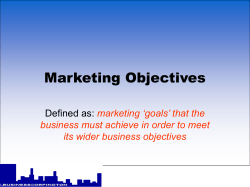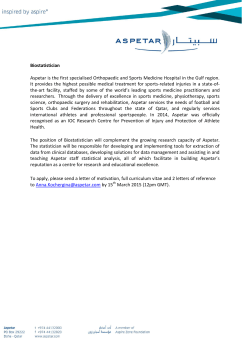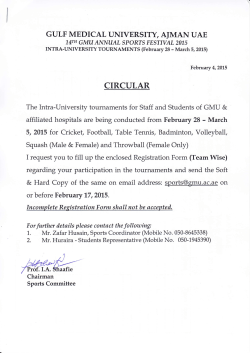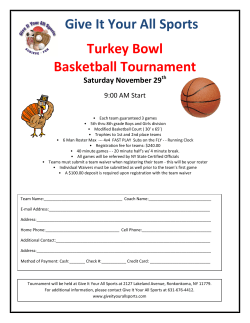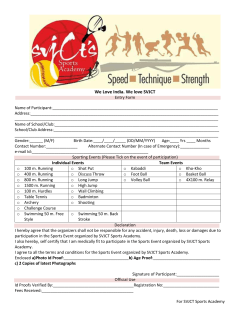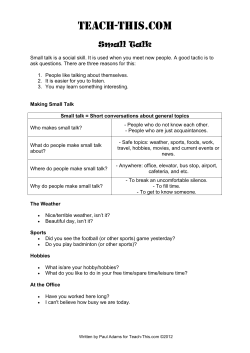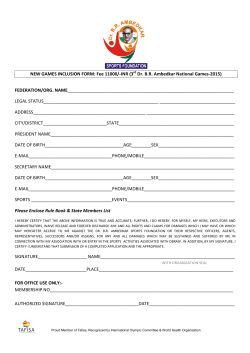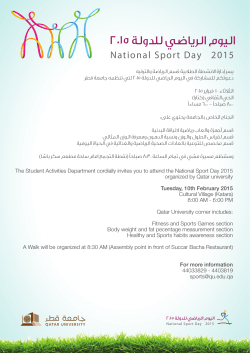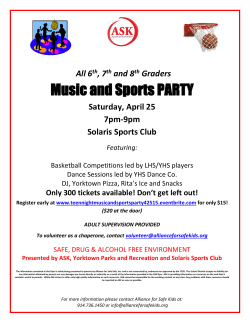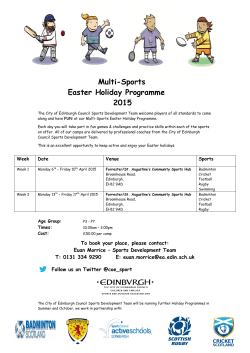
Top tips for social media use in sports and exercise medicine: doing
Downloaded from http://bjsm.bmj.com/ on July 6, 2015 - Published by group.bmj.com BJSM Online First, published on May 4, 2015 as 10.1136/bjsports-2014-094395 Top tips for social media use in sports and exercise medicine: doing the right thing in the digital age Osman Hassan Ahmed,1,2 Richard Weiler,2,3 Anthony G Schneiders,4 Paul McCrory,5 S John Sullivan6 Sports and exercise (SEM) clinicians need thick skin and a nimble brain to juggle the plethora of competing professional responsibilities; from athlete clinical care, to work/life pressures, all while developing professional knowledge and skills. In recent years there has also been an assertion that SEM clinicians need to develop/maintain a social media presence, and many working in amateur and elite sport now have Facebook, Twitter and Instagram profiles. Although professional bodies have provided social media guidance (see web appendix for additional reading) there is no explicit SEM specific social media guidance. In amateur sport, where there is not the day-to-day contact with athletes that a professional sporting environment allows, social media represents a channel of communication between the sports clinician and the athlete.1 2 In this hyperconnected age it is appropriate to interact with the athletes under our care using social media, but this needs to be carried out in a way that is professional, ethical and in keeping with the social media guidance from the respective professional organsations (see web appendix). Private discussions using social networks can help resolve communication/geographical challenges and may include multiple members of the multidisciplinary team at once, which can be beneficial while simultaneously remaining confidential (eg, WhatsApp messages and Twitter direct messages). 1 Department of Physiotherapy, Poole Hospital NHS Foundation Trust, Poole, UK; 2The FA Centre for Disability Football Research, St Georges Park, BurtonUpon-Trent, Staffordshire, UK; 3University College London Hospitals NHS Foundation Trust, London, UK; 4 School of Human, Health and Social Sciences, Central Queensland University, Branyan, Queensland, Australia; 5 The Florey Institute of Neuroscience and Mental Health, Melbourne Brain Centre, University of Melbourne, Heidelberg, Victoria, Australia; 6Centre for Health, Activity, and Rehabilitation Research, School of Physiotherapy, University of Otago, Dunedin, New Zealand Correspondence to Dr Osman Hassan Ahmed, Department of Physiotherapy, Poole Hospital NHS Foundation Trust, Longfleet Road, Poole, Dorset BH15 2JB, UK; osman.hassan.ahmed@gmail.com Sports clinicians communicating via social media need to be cognisant of their conduct in seveal areas. Confidentiality must always be respected, and broadcasted opinions on refereeing/coaching decisions may undermine the integrity of the competition and provoke team/club scrutiny and controversy. Disclosing injury statuses via social media posts is another obvious pitfall worth avoiding. ‘Trolls’ exist online in many guises,3 and high-profile clinicians who have a social media presence should avoid interaction with such individuals. For clinicians operating in professional sport, there are examples of public conflicts bringing undue attention on the clinician and club, with unwelcome consequences. Relationships that exist between medical staff and athletes often extend deeper than traditional clinician–patient relationships seen in hospitals and clinics. In most medical settings a doctor or physiotherapist may not ‘retweet’ content from their patients but sports clinicians frequently do this, possibly as a means of promoting their sport or club which may seem to be of Editorial benefit to both the individual and the organisation. Many ethical considerations from these online interactions can arise, for example, if players and staff in a squad are often seen as parts of an ‘extended family’, due to the amount of time they spend together, then is it acceptable for clinicians to ‘befriend’ their players on Facebook? Or reply to their tweets on Twitter? Or comment on their photos on Instagram? It is difficult to be prescriptive in responding to these questions, as there will be prevailing sociocultural norms and individual circumstances. Social networking with athletes can result in ‘ethical baggage’, which can complicate the clinician–patient relationship and medical care as social networking is public and a very different entity to private–personal friendship. Given how social media has become a normal part of society (and sport), it is suggested that sports clinicians embrace the media as it has the potential to enhance their practice4 and in some cases can be used to effectively deliver healthcare interventions5 and even change public health policy.6 However, it is important that clinicians are aware of the appropriate use of social media, and steps to encourage social media education for clinicians in other areas of healthcare7 should be adopted by sports medicine. We have generated a list of what we consider are social media best-practice recommendations for clinicians working in sports medicine (box 1) and hope that the sports and exercise medicine social media list Box 1 Sports and exercise medicine social media top tips 1. 2. Always respect clinical confidentiality. Embrace social media use—it is an effective tool for knowledge dissemination, promoting clinical best practice and networking with peers. 3. Think before you post—would you be happy re-reading your post in 1 week, month or years later? 4. Steer clear from trolls and puerile online arguments. Let the trolls stay in their caves. 5. Be cognisant of making a grave faux pas such as disparaging opinions on referees, tactics, releasing team and/or personal information, especially in the professional sports world. 6. When sharing images of players and colleagues, ensure you seek their informed consent prior to circulating them in the public domain. 7. Stay up to date and aware of new and emerging platforms that your players may be using (eg, snapchat). 8. In professional sports with media, marketing and communication departments, liaise with the experts to identify methods to utilise social media for wider public health benefits and to minimise risks of misinterpretation/misrepresentation. 9. Know your relevant profession’s code of ethics/conduct, or/and advocate for inclusion of social media guidance. 10. If you are working within a squad, consider acting as a reference point to help influence and generate good social media etiquette and practice. Ahmed OH, et al. Br J Sports Med Month 2015 Vol 0 No 0 Copyright Article author (or their employer) 2015. Produced by BMJ Publishing Group Ltd under licence. 1 Downloaded from http://bjsm.bmj.com/ on July 6, 2015 - Published by group.bmj.com Editorial can assist sports medicine clinicians to responsibly shape their social media presence. Social media influences many aspects of the sports medicine clinician’s practice, as shown by the use and popularity of the BJSM’s Twitter feed, with almost 21 000 followers at the start of 2015.8 Sports medicine has always been a fast-moving and dynamic area of medicine, and social media has accelerated this scope but faciliated the potential for generating myths and disseminating incorrect/inappropriate information. Careful and considered use of social media should help this evolutionary process to be safe and enjoyable for sports medicine clinicians, and ensure that business and show business remain separate in the public domain. Twitter Follow Osman Ahmed at @osmanhahmed Contributors OHA conceived the concept of this paper. All authors participated in discussing the ideas in this paper. OHA, RW and SJS generated the primary draft of this paper. All authors assisted in creating the final version of this paper. Provenance and peer review Not commissioned; externally peer reviewed. REFERENCES 1 2 3 ▸ Additional material is published online only. To view please visit the journal online (http://dx.doi.org/ 10.1136/bjsports-2014-094395). Open Access This is an Open Access article distributed in accordance with the Creative Commons Attribution Non Commercial (CC BY-NC 4.0) license, which permits others to distribute, remix, adapt, build upon this work non-commercially, and license their derivative works on different terms, provided the original work is properly cited and the use is noncommercial. See: http://creativecommons.org/licenses/ by-nc/4.0/ To cite Ahmed OH, Weiler R, Schneiders AG, et al. Br J Sports Med Published Online First: [please include Day Month Year] doi:10.1136/bjsports-2014-094395 Accepted 4 April 2015 Br J Sports Med 2015;0:1–2. doi:10.1136/bjsports-2014-094395 4 5 6 7 8 Verhagen E, Bolling C. Protecting the health of the @hlete: how online technology may aid our common goal to prevent injury and illness in sport. Br J Sports Med Published Online First: 22 January 2015 doi:10.1136/bjsports-2014-094322 Verhagen E, Bower C, Khan KM. How BJSM embraces the power of social media to disseminate research. Br J Sports Med 2014;48:680–1. The Guardian. Assaulted by trolls on social media? The high road is the only road for brands responding. 2013 (cited 19 October 2014). http://www. theguardian.com/technology/2013/nov/18/assaultedby-trolls-on-social-media-thehigh-road-is-the-only-roadfor-brands-respond Provvidenza C, Engebretsen L, Tator C, et al. From consensus to action: knowledge transfer, education and influencing policy on sports concussion. Br J Sports Med 2013;47:332–8. Ahmed OH, Sullivan SJ, Schneiders AG, et al. Ethical considerations in using Facebook for health care support: a case study using concussion management. PM&R 2013;5:328–34. Weiler R, Neyndorff C. BJSM social media contributes to health policy rethink: a physical activity success story in Hertfordshire. Br J Sports Med 2013;47:593–4. Mesko B. The Social MEDia course. 2014 (cited 19 October 2014). http://thecourse.webicina.com/ Twitter – BJSM. 2014 (cited 15 February 2015). https://twitter.com/BJSM_BMJ Competing interests None declared. 2 Ahmed OH, et al. Br J Sports Med Month 2015 Vol 0 No 0 Downloaded from http://bjsm.bmj.com/ on July 6, 2015 - Published by group.bmj.com Top tips for social media use in sports and exercise medicine: doing the right thing in the digital age Osman Hassan Ahmed, Richard Weiler, Anthony G Schneiders, Paul McCrory and S John Sullivan Br J Sports Med published online May 4, 2015 Updated information and services can be found at: http://bjsm.bmj.com/content/early/2015/05/03/bjsports-2014-094395 These include: Supplementary Supplementary material can be found at: Material http://bjsm.bmj.com/content/suppl/2015/05/04/bjsports-2014-094395. DC1.html References This article cites 4 articles, 3 of which you can access for free at: http://bjsm.bmj.com/content/early/2015/05/03/bjsports-2014-094395 #BIBL Open Access This is an Open Access article distributed in accordance with the Creative Commons Attribution Non Commercial (CC BY-NC 4.0) license, which permits others to distribute, remix, adapt, build upon this work non-commercially, and license their derivative works on different terms, provided the original work is properly cited and the use is non-commercial. See: http://creativecommons.org/licenses/by-nc/4.0/ Email alerting service Receive free email alerts when new articles cite this article. Sign up in the box at the top right corner of the online article. Topic Collections Articles on similar topics can be found in the following collections Open access (181) Notes To request permissions go to: http://group.bmj.com/group/rights-licensing/permissions To order reprints go to: http://journals.bmj.com/cgi/reprintform To subscribe to BMJ go to: http://group.bmj.com/subscribe/
© Copyright 2025
